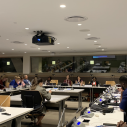
Search
Breakthrough: The power to break the poverty cycle

Electricity is a crucial proxy for multidimensional poverty, and one of its best predictors. Tackling energy poverty is of pivotal importance in the fight against multidimensional poverty (1).
These are some of the findings of the OPHI study ‘Interlinkages Between Multidimensional Poverty and Electricity‘. A study using the 2020 global MPI.
According to the OPHI-UNDP global MPI in 2020, of the total of 5.9 billion people covered in 107 countries, 922 million people couldn’t turn on a light when it got dark. They lacked access to electricity.
Of these 922 million people, who were electricity deprived, three-quarters of them (687 million) were multidimensionally poor. This means that of the 1.3 billion who were multidimensionally poor in the 107 countries covered by the global MPI, 53% lacked electricity. In other words, 53% of multidimensionally poor people lack electricity.
And most surprisingly, 99% of the people who were deprived in electricity were also deprived in at least one other indicator of poverty simultaneously, emphasising the breadth of interlinkages observed among those lacking access to electricity.
Of those deprived in electricity, 96% were also deprived in another indicator related to energy use – cooking fuel – emphasising the acute overlapping deprivations in energy access and consumption.
In addition, 86% of those deprived in electricity also live in precarious housing, built using non improved materials. 83% of those who do not have access to electricity either lack a sanitation facility, are forced to share toilets with other households, or use unimproved toilets.
If you think of the poverty cycle and the lives of poor men, women and children, often it is not characterised by a lack of just one thing, be it money, nutrition, housing, education, water, or sanitation.
Their experience is a nexus of overlapping or clustered disadvantages that strike them at the same time.
This study has put a spotlight on the fact that electricity is a key way to deal with the many aspects of multidimensional poverty for so many of the poor globally.
To break the poverty cycle, the MPI offers a way out by putting some structure into the data and by recognising the actual situation of poor people whose lives are, as stated by economist Amartya Sen, “battered and diminished in many ways simultaneously”.
This study has put a spotlight on the fact that electricity is a key way to deal with the many aspects of multidimensional poverty for so many of the poor globally. More research is needed – both quantitative and qualitative – to drive effective programming and public policy. Research is also needed to track the changes brought about over time by electrification programme interventions, paying particular attention to sequencing, interlinkages and the different pathways to tackle multidimensional poverty.
Comments by Juan Manuel Santos, Former President of Colombia at the launch of the report
‘It is common sense. People who have electricity just take it for granted. Imagine what you would do without it. So, it really is something that changes the lives of many people. This report shows the effect it has on the living standards of people, especially poor people who want to leave poverty…Here you have the opportunity to address poverty through the Multidimensional Poverty Index and because of the interlinkages concentrating on energy poverty, but at the same time producing that energy in a clean, sustainable way.’
Comments by Raj Shah, President, The Rockefeller Foundation at the launch of the report
‘The data and the insights from this Oxford analysis are really extremely important in part because in a modern economy a person without access to electricity effectively lacks the capacity to significantly improve his/her labour productivity and move themselves and other members of their community out of poverty.
Electricity access seems to cut across quite a large number of those elements of deprivation that trap people in a poverty trap and make it very difficult for them to improve their basic living conditions. For us at The Rockefeller Foundation, making investments to address energy poverty and doing that in a manner that embraces renewable energy technology is such a huge priority. We really do believe that that it is one of the critical ways to unlock the improvement of living standards broadly – in part because just electricity improves living standards and in part because of the multidimensional aspect of poverty.
The world needs more such studies and analyses and tools so that decision-makers and leaders can make informed decisions about how to set priorities. Addressing energy poverty ought to be a very, very high priority for those trying to build a more equitable future for their people.
At the end of the day this is what we have to deal with right now: we have to find the very best, the most effective, the most efficient ways to invest in a recovery that truly lifts up everybody and in particular focuses on the poor and the near-poor that are most vulnerable.
I am hopeful that the leaders of the IMF and domestic finance ministers and decision-makers throughout the world will see this Multidimensional Poverty Index and see the opportunity and say “okay, this is the moment we have to recover with equity.” We at The Foundation believe the best way to do that is through large-scale immediate investments in building out energy infrastructure that makes a difference.’
(1) The findings shared in this article come from a Report prepared by OPHI for the Rockefeller Foundation. OPHI was grateful for the opportunity to look in depth at a key indicator of multidimensional poverty.
This article was published in Dimensions 13
















